
In Monty Don's Japanese Gardens episode 1, Monty Don starts the programme in front of the snow clad Mount Fuji as our introduction to Japan.
Monty tells us that although a lot of us may have Japanese Gardens or at least Japanese plants like Maple, cherries and Hosta.
Not a lot of us really know that much about them, it is an enigma.
In Monty Don's Japanese Gardens, Monty wants to get to the heart of the Japanese Garden, and Japan which has some of the most beautiful gardens in the world.

Monty tells us that most people have an idea of what makes a Japanese garden.
Cloud pruned bushes, Maple trees, Azaleas, gravel. moss, rocks and gently flowing water.

Monty is visiting a garden that has it all. But it is not in Japan but in fact Royal Horticultural Society Tatton Park!
The story behind the garden is that it was inspired by the Japan - British Exhibition at white City in 1910.

Up until then Japan had remained a mystery for most people in Great Britain and this was their first chance at a glimpse into the culture and gardens of Japan.
Two gardens were brought over from Japan and this inspired the public to go Japanese garden crazy.
Lord Egerton after visiting the exhibition decided to create his own garden at Tatton park.
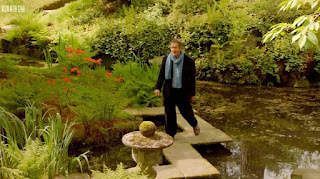
Monty however wants to see the real Japanese garden so he heads off to Japan to start his adventure.
Spring is the best time to visit Japan to see the Cherry blossom but this delicate flower only lasts a few days.
It can come at different times and can easily be ruined by the weather.
For these few precious days though, the blossom is glorious!
Monty heads off to Kanazawa in western Japan for his first garden visit to the Kenroku-en Gardens.

Kenroku-en means garden of the six sublimities and is one of the three most important gardens in Japan.
The six sublimities of the perfect garden are spaciousness, seclusion, creativity, antiquity, water courses and the view.
The garden has bridges, waterfalls, ponds and cherry blossom trees.
It was once a private garden of the Maeda clan, first created in 1670, as the grounds to the castle.
It was made into a public park in 1874.

The 28 acre garden is looked after by a team of gardeners who even weed the moss so not even a blade of grass remains, all by hand!
Monty is visiting the garden on the perfect day for the cherry blossom and he is beaming!
Hanami cherry blossom festivals have been held in Japan since the 7th Century.
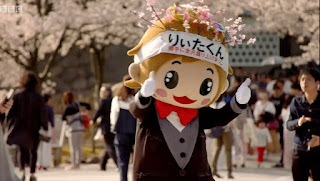
Kenroku-en gardens has every sort of Cherry blossom.
Monty meets with Professor Suzuki, a cultural expert on traditional Japanese gardens.

The Professor explains the gardens are one of the most important in Japan due to the panoramic views of the mountains and the water, making it a compacted version of Japan.
The cherry blossom is so important as a celebration of spring and they just love it.
Monty talks about the care taken over the structure in the garden, like the tree branches being supported and the meticulous attention to detail with the weeding.

Monty talks about 'Ma' which is a Shinto concept which refers to the balance and significance of the space between things.
The branches of the trees are all carefully spaced.
Monty asks about the rocks, moss and wood that you traditionally find in a Japanese garden.
The Professor explains how they make the garden in to being a naturalistic landscapes. They mimic nature.

Monty shows us the most prized cherry blossom 'Tai Haku' Great White Cherry that is still mostly in bud.
The tree had disappeared from Japan but in 1923 in a garden in Sussex, England, Captain Collingwood Ingram, a cherry blossom expert was called to identify a mystery tree and recognised it as 'Tai Haku'.
This was then grafted and taken back to Japan.
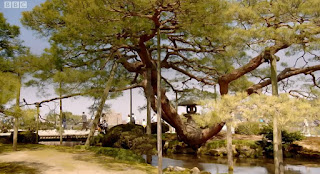
Karasaki Pine Tree is over 200 years old and has been sculptured to look natural.
The branches are propped up by huge supports.
The Head gardener Mr Shishima at Kenroku-en explains to Monty that it is a billowing, natural look they are aiming for with their tree pruning.
They prune the branches into a triangular shape creating spaces between or 'Ma'.
Once a year they hand pluck the needles, stripping away the last years growth.
Monty is amazed they do this all by hand up the huge trees!

It takes up to 60 people to strip just 1 tree. 'WOW' says Monty.
Monty then experiences Japanese train travel that not only includes a guaranteed seat on the train but also a reserved spot at the correct door on the station platform! Amazing!

Japanese garden culture is over 1500 years old and Monty heads to the cultural capital of this Kyoto.
From the 18th Century to the 19th Century, Kyoto was the capital of Japan.
In the back streets there are temples, all complete with gardens.

Monty meets local garden designer Nori Hamamoto for tea and green tea ice cream.
Monty asks about the gardens in Kyoto.
Nori says because it is surrounded by mountains and natural water it is very good for making gardens.

Nature is very strong in Japan and the Japanese people respect nature.
Nori says the cherry blossom festivals is an excuse for Japanese people to get outside as well as to celebrate by drinking.
Monty talks about the gentle delight in their celebrations in the packed streets of Kyoto for the cherry blossom.

Kimonos are hired out, romance is in the air and the cherry blossom laden trees used in wedding photos.
Monty has found this experience unforgettable.
With the symbolism of the blossom celebrating a new start of spring and the financial year for Japan it is invigorating in more ways than one.

Monty next stop in Kyoto is to a temple on its outskirts, the Enkouji Temple and its magnificent pond.
It was originally a palace in the 9th century and a dam was used to create its lake and water gardens.
This was one of the earliest Japanese water gardens, a pond, spring, boating garden.
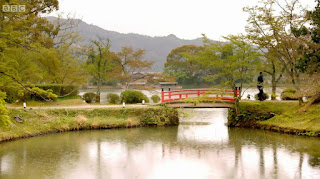
The red bridge is an iconic Japanese garden feature, in this garden they lead to islands on the lake.
Islands are an important part of the garden as the gods resided on islands.
On this Island there is an oak tree that is believed to contain a god.

To protect spirits within objects they are wrapped in rope.
Japanese monks returned from China with Buddhist teaching and made their own temples in hills and mountains for the tranquilly needed for the monks to study.

The Sanzen-in Temple in Ohara has the most amazing carpet of bright green moss with the trees giving it a cathedral type feel.
The moss grows very slowly.

The moss is very sensitive and will only grow in the right growing conditions.
We can see it as a weed that ruins our lawns but in Japan there are over 200 different types that is kept manicured and highly prized.
Bodhisattva are placed in the moss to protect the souls of children that have died.

Monty meets with a monk from the temple and asked about the connection between Buddhism and the garden.
He explains that to meet with your own inner Buddha and have a dialogue with him, where better than to do it, than in this beautiful garden.
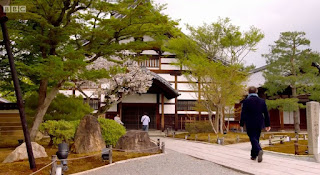
Monty next visit is to the new style of Buddhist garden that arrived in Japan 400 years later that at the Sanzen-in Temple.
Kodai-ji Temple like most Buddhist temples is surrounded by stalls selling amulets dedicated to Buddhist figures.
The temple was built in 1606 and is a very tranquil place built by a widow to mourn her lost warlord husband.

Karesansui meaning dry mountain water was a new element to Japanese gardens.
A zen garden with minimalistic planting, carefully placed rocks and raked gravel.
A garden for quiet contemplation, huge empty spaces of gravel, a few circles to break up the pattern, made to empty your mind, to gain full enlightenment.

Monty then gets an opportunity to create his own zen, in the sister temple.
The rake is designed to create parallel lines in one smooth motion.
Monty eventually got the hang of it!

The process in Zen Buddhism is more important then the outcome, focusing on the task in hand, breathing all creates a state of calm and meditation.
Gardening is a relaxing hobby but too many of us are focused on results in our garden, the best veg, the border full of flowers, we need to be more zen, enjoy raking the leaves!
Pete Free 🌻

Zen gardens are a recreation of the type of ink painting above.
Monty speaks to Mr Kitayama master garden designer, who explains that these gardens came about at a time when land and water were hard to come by.
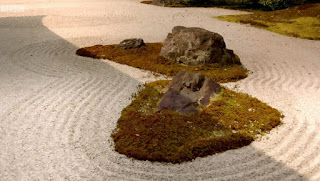
He also stresses the importance at looking with your heart, not your eyes, whether it is a nice garden or not.
It is about how it has made you feel.
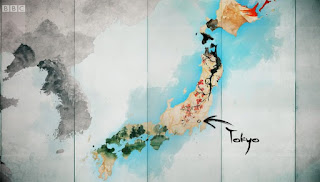
Tsurumi Railway Station, Tokyo is an unlikely place to find a garden.
Found on the rooftop is a quiet zen gravel garden designed by Shunmyo Masuno.

Monty asks Mr Masuno how relevant the garden is today?
He says people have busy lives working and he hopes they take time to enjoy the fresh air and see the beautiful sky.

He explains that Zen is very simple and by using only stone, wood and soil to create the garden.
Monty thought it was concrete but it is compacted soil.
The rake is designed to create parallel lines in one smooth motion.
Monty eventually got the hang of it!

The process in Zen Buddhism is more important then the outcome, focusing on the task in hand, breathing all creates a state of calm and meditation.
Gardening is a relaxing hobby but too many of us are focused on results in our garden, the best veg, the border full of flowers, we need to be more zen, enjoy raking the leaves!
Pete Free 🌻

Zen gardens are a recreation of the type of ink painting above.
Monty speaks to Mr Kitayama master garden designer, who explains that these gardens came about at a time when land and water were hard to come by.

He also stresses the importance at looking with your heart, not your eyes, whether it is a nice garden or not.
It is about how it has made you feel.

Tsurumi Railway Station, Tokyo is an unlikely place to find a garden.
Found on the rooftop is a quiet zen gravel garden designed by Shunmyo Masuno.

Monty asks Mr Masuno how relevant the garden is today?
He says people have busy lives working and he hopes they take time to enjoy the fresh air and see the beautiful sky.

He explains that Zen is very simple and by using only stone, wood and soil to create the garden.
Monty thought it was concrete but it is compacted soil.

Mr Masuno has to accept the un-natural vending machine in the garden.
The second part of the garden is a more traditional gravel garden.

Mr Masuno says 'it is for enrichment, it is not perfect, imperfect is our beauty'.
'mu' is empty space and is also present in his garden design.
Mu has no context or definition.
Monty asks how do you know when its right?

Mr Masuno says the stone tells him, what angle, what is right.
After several bows Monty tells us its hard for us Western gardeners to see this as a place of beauty.
The natural meeting 21st Century life, can work together, if you let them and open your heart.

In 1939 a designer working at Tofuku-Ji Temple caused an uproar with his modern design of upright rocks.

Mirei Shigemori one of the great garden designers of the 20th century, was to create gardens around the hall, that were too shock, with the grouping and positioning of the rocks.

His new design ideas were to go against a 1000 years of Japanese garden design.
In the Japanese book Sakuteki Visions of the Japanese Garden (a modern translation), it says it is bad luck to place the stones as Mr Shigemori had done in his new design.
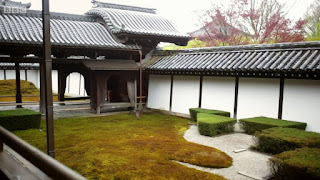
Monty first visited 10 years ago but it is the use of moss that stuck with him.
In one garden it has waves of moss and in another is the chequerboard design that has remained with Monty since his last visit.

Monty recalls the ill health he had after his visit to the garden and he spent a lot of time just thinking, a lot of the time about his mortality.
The garden played a big part in his thinking, the predictable regular pattern of life at the start and how it breaks down and merges to one but is still as vibrant.
How life is running through all things.
For the garden to do this Monty says 'is a work of genius'.

Stone unites all styles of Japanese zen gardens.
Monty arrives in Okazaki on the East coast of Japan, which is famous for its stone mason and lanterns.

It even has the chisel as its mascot.
Since the 16th Century, stonemasons have been in Okazaki,.
Monty is meeting with Azusa Ueno, a female stonemason.

She is one of the few female stonemasons and started at 18 years old.
It takes 10 years to become a master.
Monty wants to have a go but first she explains the angle as well as how hard you hit the chisel is important.

Monty apparently is very good at it!
Monty felt privileged to be allowed to have a go and connect with the stone.
Tea gardens are our next ummm tea break on Monty's travels.

Tea arrived in the 9th Century in Japan from China.
The tea ceremony or Wabi-cha is highly ritualised ceremony.
It is still as popular with modern tea drinkers.

The 16th Century say the emergence of tea gardens or Roji, were built around tea house.
The approach to the tea houses were an important part of the whole experience.
Monty visits the Toyobo tea house at Kenninji Temple in Kyoto.

As you approach a tea house all the grandeur needed to slip away and everyone enters the teahouse as equals.
The path to the tea house is not straight or even, you need to concentrate and slows you down.
The plants and rocks on the journey are all made to look natural.

Your view is obscured by the greenery so that it envelops you so you focus on what is to come at the ceremony.
Stone basins (pictured above) are placed so you can cleanse yourself on the journey.
You enter through a tiny door so the last shreds of self importance are shed.

Monty opts for a less formal tea ceremony.
The tea is very strong but first you have something sweet for your palate (quince paste), as the tea is very bitter.

Monty says the tea is 'an acquired taste but will keep you awake'.
In contemporary Japan there are more non-traditional tea houses and Monty visits the home of Mr & Mrs inoue at Tokusho-ji Temple.

The garden was destroyed by an earthquake in 1995 and it is the current garden Monty has come to see.
After his green tea of course, nothing is rushed in Japan!
The tea is very strong but first you have something sweet for your palate (quince paste), as the tea is very bitter.

Monty says the tea is 'an acquired taste but will keep you awake'.
In contemporary Japan there are more non-traditional tea houses and Monty visits the home of Mr & Mrs inoue at Tokusho-ji Temple.

The garden was destroyed by an earthquake in 1995 and it is the current garden Monty has come to see.
After his green tea of course, nothing is rushed in Japan!
The garden and teahouse were designed by their friend and architect Terunobu Fujimori.

The garden contains very little in the way of green except the arch which represents the arch to heaven you pass through in Buddhist culture.
The snake represents the river you cross.

To get into the teahouse it has a very low and small opening as with a traditional tea houses you need to crawl in.
The modern twist is it is raised like a tree house and accessed via a ladder.


Inside it is beautifully set up with everything you need for a tea ceremony.
It is just stunning!

Space in Japan is a luxury with it being in very short supply.
People make do with pots outside their houses and wherever they can grow things.
This lack of growing space has lead to people enjoying the past time of Ikebana.

Monty visits Rokkaku-do Temple in Kyoto to visit the oldest and most well known one Ikenobo.
The art of arranging started in the 7th Century when flowers left for offerings to the gods were deemed to need to be arranged suitably.
Monty was invited to attend a class but they were way to advanced for new comer Monty. So he just watched.
After buying materials, Monty is off for a private Ikebana lesson from Senko Ikenobo, Deputy Head Mistress.

The garden contains very little in the way of green except the arch which represents the arch to heaven you pass through in Buddhist culture.
The snake represents the river you cross.

To get into the teahouse it has a very low and small opening as with a traditional tea houses you need to crawl in.
The modern twist is it is raised like a tree house and accessed via a ladder.


Inside it is beautifully set up with everything you need for a tea ceremony.
It is just stunning!

Space in Japan is a luxury with it being in very short supply.
People make do with pots outside their houses and wherever they can grow things.
This lack of growing space has lead to people enjoying the past time of Ikebana.

Monty visits Rokkaku-do Temple in Kyoto to visit the oldest and most well known one Ikenobo.
The art of arranging started in the 7th Century when flowers left for offerings to the gods were deemed to need to be arranged suitably.
Monty was invited to attend a class but they were way to advanced for new comer Monty. So he just watched.
After buying materials, Monty is off for a private Ikebana lesson from Senko Ikenobo, Deputy Head Mistress.

Unfortunately it is very unusual with Ikebana to have just one thing to work with as its usual to create a harmony between several plants in the arrangement.
Monty has failed before he has started!
Less is only more when it comes to focusing on each individual branches and its beauty.

After checking the angles, and then trying to capture the wind blowing through, Monty starts snipping off the branches and bending them.
I am not sure Monty is going to be asked back for the master class!
But as Monty says its all about the 'Ma' the controlled space, and he enjoyed the process.
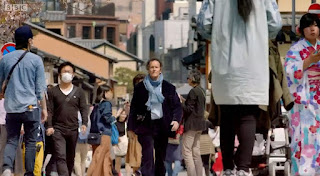
Monty ends this first Spring Episode to Japan talking about the journey he has been on and how everything is deliberate in Japanese gardens.
He will go and contemplate what he has learnt, from the knowledge he has gained.
To return for Autumn to continue his journey....
All photographs are copyright of BBC.com
Japanese Gardens: a Journey
Monty Don & Derry Moore
Sakuteki Visions of the Japanese Garden
Jiro Takei & Marc P Keane
Monty Don's Japanese Gardens Books
Monty Don & Derry Moore
Sakuteki Visions of the Japanese Garden
Jiro Takei & Marc P Keane
Share this post



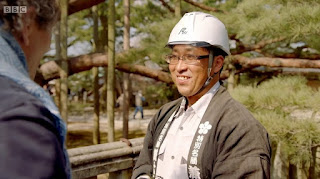
No comments:
Post a Comment